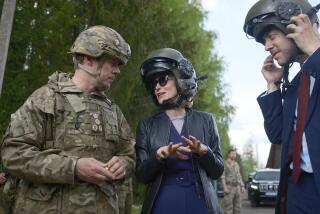Air Force Takes Delivery of Troubled C-17 Cargo Jet : Military: Doubts persist the McDonnell Douglas plane will perform as promised. It faces flight restrictions.
After seven difficult years of development, McDonnell Douglas Corp. on Monday handed over the first C-17 cargo jet to the Air Force in an elaborate ceremony in Charleston, S.C. But even in its moment of glory, the aircraft remains dogged by criticism and doubts that it will perform as promised.
The bulbous gray aircraft the Air Force accepted fell short of the plane the government originally ordered. The C-17 arrived with 125 “waivers and deviations” from the requirements of the contract--meaning that equipment did not measure up to original specifications.
Problems range from minor cosmetic glitches to several that involve the plane’s complex computer software system, which has been stung by controversy in recent weeks. As a result, the Air Force withheld $5.3 million in payments to McDonnell.
Air Force leaders, however, praised the airplane at the ceremony attended by 3,500 officials. The plane was piloted into Charleston from a nearby base by the Air Force’s chief of staff, Gen. Merrill McPeak--a powerful endorsement of the $42-billion program.
The delivery also buoyed investor confidence in McDonnell, sending its stock up $1.75 to close at $70.375 a share in New York Stock Exchange trading, a 52-week high.
The new plane will enter service at Charleston Air Force Base with restrictions on the conditions under which it can fly. Those limits were imposed this month after an incident in March in which a C-17 test aircraft nearly crashed at Edwards Air Force Base.
The C-17, which is built in Long Beach, has emerged as the most controversial program at the Pentagon. It has become a lightning rod for controversy surrounding the post-Cold War military procurement system, in which every major weapon system has attracted platoons of powerful proponents and critics--within the Pentagon, the defense industry and Congress.
Programs like the C-17 have become a focal point for cutting defense spending in Congress. Even McDonnell’s arch-rival, Lockheed, has told critics that it could save the nation $11 billion by building more of its older C-5B cargo aircraft.
“The problem is that we still have not found ways to reduce defense spending to the levels that we want,” said John Harbison, head of aerospace practice at the Booz Allen & Hamilton consulting firm. “It is just a handful of programs that are sizable enough to make a dent in the budget and when one comes along that has any warts, it can be quite vulnerable.”
The C-17, intended to replace the 30-year-old C-141 cargo planes, has enjoyed strong support by both the Air Force and the Army. It is touted as a weapon whose importance has grown with the end of the Cold War, as the United States faces potential military threats that require massive cargo lifts.
Still, the C-17 remains dogged by serious difficulties. The program is over budget by an estimated $1.4 billion for developing the plane and building the first six aircraft. It is more than a year behind schedule.
Amid the sniping, the Defense Department is weighing a possible cancellation of McDonnell’s C-17 contract, pending a massive report by an independent review team that will be submitted to Under Secretary of Defense John Deutch next month.
Despite the possibility of cancellation, the investment firm Duff & Phelps Credit Rating Co. said Monday that it believes “the chance of elimination of the program is remote.”
During the incident in March, a C-17 test plane stalled, then plunged from an altitude of about 8,000 feet to 1,700 feet. The planes’s nose pitched upward and the aircraft fell “sort of like a leaf drops from a tree,” an Air Force official said Monday.
Lt. Col. Terry Tomeny, director of the C-17 testing program at Edwards said the incident resulted from “pushing too hard” and that the program had “dug too deeply into our safety margin,” according to briefing papers obtained by The Times.
As a result of the concerns, testing of the plane has been extended for 11 months, although the C-17 will continue to fly with limitations.
A stall occurs when a plane loses lift.
The Air Force placed restrictions on the operation of the plane delivered to Charleston to make certain another stall did not occur, according to military documents, copies of which were obtained by The Times.
The restrictions--intended to increase the safety of the C-17 to avoid a stall--include a limit on the aircraft’s minimum speed, its center of gravity and the angle at which it can fly. The Air Force was forced to carry a pallet of ballast in the back of the plane when it flew across country this weekend, ensuring that the nose would not pitch up.
The service is also requiring that an instructor pilot fly with all crews, an Air Force spokesman said Monday.
More to Read
Start your day right
Sign up for Essential California for news, features and recommendations from the L.A. Times and beyond in your inbox six days a week.
You may occasionally receive promotional content from the Los Angeles Times.







